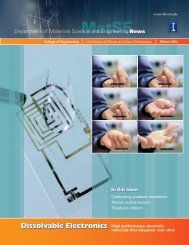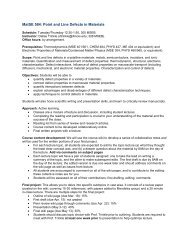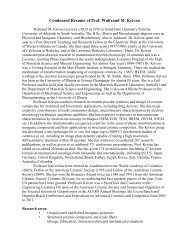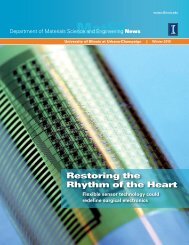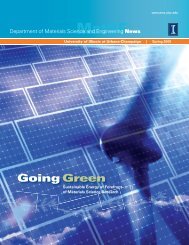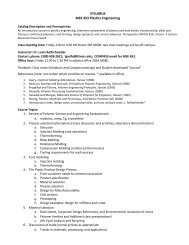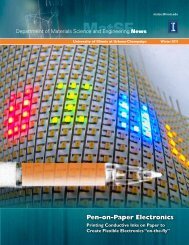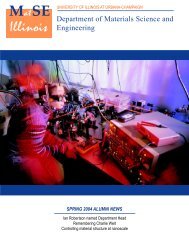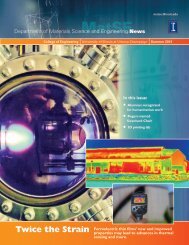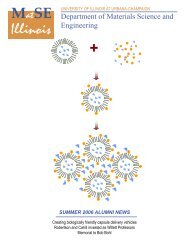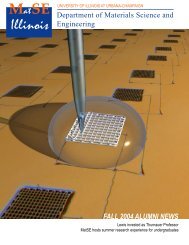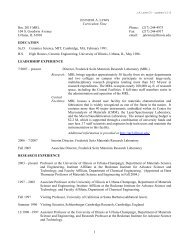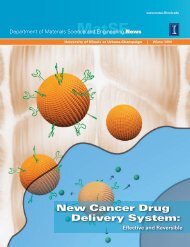Coatings Self-Repair - Department of Materials Science and ...
Coatings Self-Repair - Department of Materials Science and ...
Coatings Self-Repair - Department of Materials Science and ...
Create successful ePaper yourself
Turn your PDF publications into a flip-book with our unique Google optimized e-Paper software.
MatSE<br />
<strong>Department</strong> <strong>of</strong> <strong>Materials</strong> <strong>Science</strong> <strong>and</strong> Engineering News<br />
www.matse.illinois.edu<br />
University <strong>of</strong> Illinois at Urbana-Champaign | Summer 2009<br />
<strong>Coatings</strong> <strong>Self</strong>-<strong>Repair</strong><br />
<strong>Self</strong>-healing greatly<br />
extends the life <strong>of</strong><br />
paints <strong>and</strong> coatings
From the <strong>Department</strong> Head<br />
Dear Alumni,<br />
I have now completed more than six years here, serving<br />
first as the interim Head <strong>and</strong> then as the Head <strong>of</strong> the<br />
department. It has been a great experience, but I came<br />
to the decision earlier in this semester that it was time<br />
for a change, both for me <strong>and</strong> for the department. I<br />
can think <strong>of</strong> no better time for a change—I was told it<br />
is best to step away when you are on top <strong>and</strong> I believe<br />
today that is where we are. Our student population has<br />
reached record numbers, <strong>and</strong> we continue to attract the<br />
best <strong>and</strong> brightest. I know you will be proud to welcome<br />
them to your ranks in the coming years. The faculty<br />
continues to excel, bringing new <strong>and</strong> exciting research<br />
programs that will pave the way to find technological<br />
solutions to many <strong>of</strong> the challenging issue our nation<br />
faces today. I continue to be impressed by the visionary<br />
<strong>and</strong> high quality research they <strong>and</strong> their students<br />
conduct. We, despite the challenging economic times,<br />
have hired a new faculty member, Lane Martin. Lane<br />
will be introduced to you in the Fall newsletter, <strong>and</strong> I am<br />
sure you will be impressed with his plans for the future.<br />
Shen Dillon will <strong>of</strong>ficially join the faculty ranks in the fall,<br />
too. Your generosity to <strong>and</strong> support <strong>of</strong> the department<br />
continues to grow, <strong>and</strong> it is hard to imagine a better <strong>and</strong><br />
more loyal group <strong>of</strong> alumni. I could go on <strong>and</strong> list more<br />
achievements but … well, I am sure you get the idea.<br />
Our st<strong>and</strong>ing is perhaps best summed up in the words<br />
institution, this is high praise indeed. All <strong>of</strong> us, faculty,<br />
staff, students <strong>and</strong> alumni, should be immensely proud<br />
<strong>of</strong> this achievement for we have all made important<br />
contributions.<br />
Behind my success as Head <strong>of</strong> your department have<br />
been many people <strong>and</strong> I would like to take this opportunity<br />
to acknowledge the contribution <strong>of</strong> just a few <strong>of</strong><br />
them. First <strong>and</strong> foremost, my wife Victoria <strong>and</strong> our son<br />
David, for without their love, underst<strong>and</strong>ing <strong>and</strong> support,<br />
none <strong>of</strong> this would have been possible; Kathy Dysart <strong>and</strong><br />
Judy Brewer, my protectors; Jay Menacher for always<br />
finding the resources for all our projects; Angus Rockett<br />
<strong>and</strong> Phil Geil, my associate heads, for their advice <strong>and</strong><br />
wise counsel <strong>and</strong> for keeping me from straying too far<br />
<strong>of</strong>f path; <strong>and</strong> to all the other staff members: Cindy Brya,<br />
Debbie Kluge, Michelle Malloch, Bryan Kieft, John Bukowski<br />
<strong>and</strong> Dawn S<strong>and</strong>one. They are incredibly dedicated<br />
to the department <strong>and</strong> are critical to its success.<br />
Finally, I want to take this opportunity to thank you,<br />
the students, both past <strong>and</strong> present, for making us great.<br />
Our achievements would not have been possible without<br />
you. It has been an honor <strong>and</strong> privilege to have been<br />
given the opportunity to serve as the Head <strong>of</strong> this<br />
great department.<br />
Thank you.<br />
from a member <strong>of</strong> the external review committee who<br />
described the department as being what all materials<br />
science <strong>and</strong> engineering departments should aspire to<br />
be. Coming from a fellow department head at a peer<br />
Ian M. Robertson<br />
<strong>Materials</strong> <strong>Science</strong> <strong>and</strong> Engineering | Summer 2009
Reprinted with permission<br />
from the article “Golden<br />
Eagle – Retired baby boomers<br />
discover second careers<br />
in the national parks,”<br />
Jackson Hole Magazine<br />
(Summer/Fall 2008)<br />
The <strong>Science</strong> <strong>of</strong> Hiking<br />
The simple language that Joe Greene uses to explain the<br />
intricacies <strong>of</strong> nanoscience belie the complexity <strong>of</strong> interatomic<br />
interaction. It’s a topic Greene spent more than<br />
30 years investigating <strong>and</strong> one on which he has become<br />
an internationally recognized<br />
expert. The first in his family<br />
to attend college, Greene<br />
earned a doctorate degree in<br />
chemistry <strong>and</strong> physics before<br />
accepting a teaching position<br />
at the University <strong>of</strong> Illinois. “I<br />
ran out <strong>of</strong> degrees,” he says<br />
wryly. “It pissed me <strong>of</strong>f. I had<br />
to get a job.”<br />
In the following years,<br />
Greene <strong>and</strong> his wife Phyllis,<br />
an international flight<br />
attendant, traveled the<br />
globe as he juggled teaching<br />
responsibilities at Illinois<br />
<strong>and</strong> at Sweden’s Linkoping<br />
University. He also spent<br />
time consulting, lecturing<br />
<strong>and</strong> teaching short courses in<br />
nanoscience in other foreign<br />
countries. But Greene<br />
shocked colleagues when, at<br />
the height <strong>of</strong> his career, he<br />
<strong>and</strong> Phyllis opted for semiretirement<br />
<strong>and</strong> moved to<br />
Jackson, Wyoming. Co-workers<br />
predicted they would last<br />
five months before going<br />
“stark raving mad,” he says.<br />
“But we’ve always been sort<br />
<strong>of</strong> weird that way. Scientists at a very high international<br />
level really don’t do anything but science…But [Phyllis <strong>and</strong><br />
I] have always had other interests.”<br />
A yoga class, taught by Jerry Fussel at the Senior Center<br />
<strong>of</strong> Jackson Hole, led Greene to his current position as a<br />
volunteer ranger in Gr<strong>and</strong> Teton National Park. He never<br />
had been involved in volunteering, a foreign concept in the<br />
highly competitive world <strong>of</strong> research science, where he<br />
says, dollars are few <strong>and</strong> projects numerous <strong>and</strong> expensive.<br />
Fussel, a retired nuclear engineer involved in a variety <strong>of</strong><br />
projects in the community, suggested to Greene that he<br />
apply to be a volunteer backcountry ranger—a post Fussel<br />
once held (he was one <strong>of</strong> the first in the valley to do so).<br />
“The first year he suggested it, I thought he was<br />
nuts,” Greene says. “But he kept working on me. [And]<br />
Phyllis thought it was a great idea.” Greene credits his<br />
wife, honored locally as the Senior Citizen <strong>of</strong> the Year<br />
in 2007, as a shining example <strong>of</strong> one with the volunteer<br />
ethic. She gave him the necessary push to begin donating<br />
his own time to others.<br />
In the summer <strong>of</strong> 2006, Greene donned his Park<br />
Service uniform <strong>and</strong> headed into the Tetons, charged<br />
with the tasks <strong>of</strong> helping visitors, monitoring humanwildlife<br />
interactions <strong>and</strong> assisting with pertinent backcountry<br />
tasks. Along with time alone in the backcountry,<br />
moments Greene describes as his own form <strong>of</strong> religion,<br />
volunteering has yielded other unexpected benefits. “I’m<br />
really an asocial physicist, a typical science geek who<br />
isn’t comfortable at parties. This has helped me learn<br />
how to be more comfortable with groups <strong>of</strong> people.”<br />
And some <strong>of</strong> those groups are people he likely never<br />
would have interacted with. Greene recalls one evening<br />
spent on the Death Canyon Shelf, where he ran into 16<br />
girls from the inner city <strong>of</strong> Chicago. The girls were “absolutely<br />
<strong>of</strong>f the wall” when separated from their cigarettes<br />
<strong>and</strong> city surroundings, he explains. “But we stayed all<br />
night, just talking about life, physics, their problems,<br />
showing them black holes.”<br />
Greene’s background not only qualifies him to talk<br />
about black holes with park visitors but also allows him to<br />
empathize with those new to the wilds <strong>of</strong> Wyoming. It’s<br />
a perspective longtime residents sometimes forget. “The<br />
typical type [<strong>of</strong> tourist] I know very well,” he says. “They<br />
know canyons, but it’s a different kind <strong>of</strong> canyon—one<br />
running down the middle <strong>of</strong> Manhattan…They can be terrified.<br />
It’s really reassuring to see someone in a uniform.”<br />
Greene hasn’t entirely kissed the world <strong>of</strong> science<br />
good-bye. He still travels up to 200,000 miles by air each<br />
year, about half the number <strong>of</strong> miles he logged before<br />
semi-retiring. “I still have the intellectual satisfaction <strong>of</strong><br />
doing very high-level science, consulting with foreign<br />
governments, presidents, ministers <strong>of</strong> science, but I can<br />
come home to Jackson <strong>and</strong> ski my butt <strong>of</strong>f <strong>and</strong> volunteer<br />
in the park,” he says. Greene tries to schedule the majority<br />
<strong>of</strong> his traveling in the winter <strong>and</strong> shoulder seasons,<br />
allowing him to work three days <strong>and</strong> two nights a week<br />
in the park in the summer. He spends an additional<br />
half-day accompanying Phyllis, who also volunteers in<br />
the park on patrols.<br />
Greene is satisfied with the balance he has achieved<br />
in life. In winter, he ski tours up his favorite haunt, Mail<br />
Cabin Creek, any chance he gets. He hasn’t let his<br />
“golden years” slow him down one bit. When asked his<br />
age, he fumbles for his wallet <strong>and</strong> does the math aloud.<br />
“Sixty-three years old. We don’t celebrate birthdays<br />
or anniversaries. We celebrate every day we wake up<br />
healthy. That’s a great day.”<br />
www.matse.illinois.edu | University <strong>of</strong> Illinois at Urbana-Champaign 1
New Polymer <strong>Coatings</strong> Prevent Corrosion,<br />
Even<br />
When<br />
Scratched<br />
Imagine tiny cracks in your patio<br />
table healing by themselves, or<br />
the first small scratch on your new<br />
car disappearing by itself. This <strong>and</strong><br />
more may be possible with selfhealing<br />
coatings being developed<br />
at the University <strong>of</strong> Illinois.<br />
Illinois researchers Paul Braun (PhD MatSE ’98), right, <strong>and</strong> Scott White have created self-healing coatings<br />
that automatically repair themselves <strong>and</strong> prevent corrosion <strong>of</strong> the underlying substrate.<br />
The new coatings are designed to better protect materials from the effects <strong>of</strong> environmental exposure.<br />
Applications range from automotive paints <strong>and</strong> marine varnishes to the thick, rubbery coatings on patio<br />
furniture <strong>and</strong> park benches.<br />
“Starting from our earlier work on self-healing materials at the University, we have now created self-healing<br />
coatings that automatically repair themselves <strong>and</strong> prevent corrosion <strong>of</strong> the underlying substrate,” said Paul Braun,<br />
a University Scholar <strong>and</strong> MatSE pr<strong>of</strong>essor. Braun is corresponding author <strong>of</strong> a paper published in the journal<br />
Advanced <strong>Materials</strong>.<br />
To make self-repairing coatings, the researchers first encapsulate a catalyst into spheres less than 100<br />
microns in diameter (a micron is 1 millionth <strong>of</strong> a meter). They also encapsulate a healing agent into similarly<br />
sized microcapsules. The microcapsules are then dispersed within the desired coating material <strong>and</strong> applied<br />
to the substrate.<br />
2 <strong>Materials</strong> <strong>Science</strong> <strong>and</strong> Engineering | Summer 2009
“By encapsulating both the catalyst <strong>and</strong> the healing<br />
agent, we have created a dual capsule system that<br />
can be added to virtually any liquid coating material,”<br />
Braun said. When the coating is scratched, some <strong>of</strong><br />
the capsules break open, spilling their contents into the<br />
damaged region. The catalyst <strong>and</strong> healing agent react,<br />
repairing the damage within minutes or hours, depending<br />
upon environmental conditions.<br />
The performance <strong>of</strong> the self-healing coating system<br />
was evaluated through corrosion testing <strong>of</strong> damaged<br />
<strong>and</strong> healed coated steel samples compared to control<br />
samples that contained no healing agents in the coating.<br />
Reproducible damage was induced by scratching<br />
through the 100-micron-thick polymer coating <strong>and</strong> into<br />
the steel substrate using a razor blade. The samples were<br />
then immersed in a salt solution <strong>and</strong> compared over time.<br />
The control samples corroded within 24 hours <strong>and</strong> exhibited<br />
extensive rust formation, most prevalently within the<br />
groove <strong>of</strong> the scratched regions, but also extending across<br />
the substrate surface, the researchers report. In dramatic<br />
contrast, the self-healing samples showed no visual<br />
evidence <strong>of</strong> corrosion even after 120 hours <strong>of</strong> exposure.<br />
“Our dual capsule healing system <strong>of</strong>fers a general<br />
approach to self-healing coatings that operates across a<br />
broad spectrum <strong>of</strong> coating chemistries,” Braun said. “The<br />
microcapsule motif also provides a delivery mechanism<br />
for corrosion inhibitors, antimicrobial agents <strong>and</strong> other<br />
functional chemicals.”<br />
With Braun, the paper’s co-authors are University <strong>of</strong><br />
Illinois Aerospace Engineering pr<strong>of</strong>essor Scott White,<br />
<strong>and</strong> former MatSE graduate student Soo Hyoun Cho.<br />
A company formed by Braun, White <strong>and</strong> other Illinois<br />
researchers is exploring commercialization <strong>of</strong> the selfhealing<br />
coatings technology.<br />
The work was funded by Northrop Grumman Ship<br />
Systems, the U.S. Air Force Office <strong>of</strong> Scientific Research<br />
<strong>and</strong> the Beckman Institute.<br />
-University <strong>of</strong> Illinois News Bureau<br />
The new coatings would protect<br />
the finish on a park bench.<br />
The background images show the<br />
dramatic reduction in corrosion<br />
<strong>of</strong> steel plates coated with a selfhealing<br />
coating (right) as compared<br />
to a conventional coating (left)<br />
after they were scratched <strong>and</strong><br />
subsequently immersed in 5%<br />
salt (NaCl) water for five days. The<br />
foreground pictures are scanning<br />
electron microscope images <strong>of</strong><br />
the control (left) <strong>and</strong> healed (right)<br />
scratch showing the healing <strong>of</strong> the<br />
scratch in the self-healing coating.<br />
www.matse.illinois.edu | University <strong>of</strong> Illinois at Urbana-Champaign 3
Observing Atoms through the Corrective Lenses<br />
<strong>of</strong> Transmission Electron Microscopes<br />
By Jian-Min Zuo<br />
The magnifying power <strong>of</strong> a glass lens was recorded as<br />
early as the 8th century BC in ancient Egyptian hieroglyphs,<br />
which depict “simple glass meniscal lenses.”<br />
Transforming glass lenses to microscopes with high magnifying<br />
powers, however, took a long time. There were<br />
many materials issues involved with making clear glasses<br />
that were slowly solved in Europe. Polishing the glass<br />
pieces into fine convex shapes for a magnifying lens also<br />
was a technique that only a few mastered until the time<br />
<strong>of</strong> the Dutchman, Antony van Leeuwenhoek (1632-1723).<br />
Leeuwenhoek was a tradesman from Delft, Holl<strong>and</strong>. He<br />
had no family fortune <strong>and</strong> received no scientific training.<br />
What he had was the immense curiosity to see the small<br />
world that lives with us. With skill <strong>and</strong> diligence, Leeuwenhoek<br />
mastered the art <strong>of</strong> making minuscule glass lenses.<br />
He mounted the lens onto a tiny hole in a brass plate <strong>and</strong><br />
attached a sharp needle on which he mounted his specimens.<br />
Using this, he discovered bacteria, sperm cells,<br />
blood cells <strong>and</strong> much more. His work brought an entire<br />
world <strong>of</strong> microscopic life to the awareness <strong>of</strong> scientists.<br />
The optical microscopes we use today are much more<br />
sophisticated instruments than the primitive, single<br />
lens, microscopes Leeuwenhoek built. But they are all<br />
subjected to the resolution limit, first discovered by the<br />
Nobel laureate, Lord Rayleigh (1842-1919). He found that<br />
the best resolution an optical microscope can achieve<br />
is about 0.6 times the light wavelength divided by the<br />
numerical aperture <strong>of</strong> the lens. The wavelength <strong>of</strong> visible<br />
lights ranges from 390 to 780 nanometers (a billionth <strong>of</strong><br />
a meter). With a numerical aperture on the order <strong>of</strong> one,<br />
the resolution <strong>of</strong> the optical microscope at best is around<br />
300 nm using blue light.<br />
The first transmission electron microscope (TEM) was<br />
built in 1931 by Enrst Ruska together with Max Knoll.<br />
TEMs use high energy electrons <strong>of</strong> several hundred<br />
kilovolts traveling at speeds close to 2/3 <strong>of</strong> the speed <strong>of</strong><br />
light for illumination. Magnetic lenses are used for focusing<br />
these electrons. Electrons behave similar to light thanks to<br />
the peculiar quantum mechanical effect <strong>of</strong> a particle having<br />
a wavelength <strong>of</strong> the Planck constant divided by the particle<br />
momentum. The electron wavelengths used in transmission<br />
electron microscopes ranges from 4 to 1 picometers<br />
(10 -12 meter). The numerical aperture <strong>of</strong> electron microscopes<br />
is on the order <strong>of</strong> 10 -1 . The theoretical resolution <strong>of</strong><br />
4 <strong>Materials</strong> <strong>Science</strong> <strong>and</strong> Engineering | Summer 2009
the electron microscopes, according to Lord Rayleigh, is<br />
less than an ångstrom (100 picometers).<br />
The transmission electron microscopes used by<br />
generations <strong>of</strong> materials scientists <strong>and</strong> engineers have had<br />
resolutions about 20 times worse than their theoretical<br />
limits. The poorer resolution was caused by the aberrations<br />
<strong>of</strong> the magnetic lens. The electron magnetic lens uses the<br />
fringe fields <strong>of</strong> a cylindrical shaped magnetic circuit (round<br />
lens) for focusing; the field is stronger away from the lens<br />
axis <strong>and</strong> consequently electrons traveling away from the<br />
axis are focused more than those traveling close to the<br />
axis. This effect is called spherical aberration. The spread<br />
in the focal distances caused by spherical aberration limits<br />
the resolution <strong>of</strong> the electron microscopes. The amount<br />
<strong>of</strong> focus spread is proportional to the spherical aberration<br />
coefficient C s <strong>and</strong> the square <strong>of</strong> the <strong>of</strong>f-axis distance divided<br />
by the lens focal length. Electron microscopes designed for<br />
high resolution imaging typically have a C s <strong>of</strong> 0.5 to 1 mm.<br />
The C s is positive corresponding to the over focus <strong>of</strong> <strong>of</strong>f-axis<br />
electrons. For a 200 kilovolt electron microscope, the C s<br />
limited resolution is about 2 ångstroms.<br />
In optical microscopes, a glass lens with positive C s<br />
can be corrected by using a glass lens with a negative C s .<br />
However, in magnetic lenses, Otto Scherzer, a German<br />
electron optician, pointed out that all cylindrical magnetic<br />
lenses have positive C s . In order to correct the aberration<br />
in magnetic lenses, a non-cylindrical magnetic lens with<br />
a negative C s must be used. One lens that meets this<br />
requirement is a thick magnetic hexapole lens made <strong>of</strong><br />
three magnetic dipoles. However, the hexapole lens,<br />
like any other multipole lenses, has strong lower order<br />
aberrations (the C s is a third order aberration), which if<br />
not removed will place a greater limit on the resolution<br />
than the C s . The first successful corrector for a TEM was<br />
built by a German team led by Max Haider using the<br />
two magnetic hexapole design <strong>of</strong> Harold Rose. The two<br />
magnetic hexapoles are symmetric <strong>and</strong> they are arranged<br />
with the help <strong>of</strong> two additional round lenses to cancel<br />
each other’s lower order aberrations. Ondrej Krivanek <strong>of</strong><br />
NION corporation, Seattle, built the first electron probe<br />
corrector using a combination <strong>of</strong> magnetic quadrupoles.<br />
The aberration correction improves the resolution <strong>of</strong> a 200<br />
kilovolts electron microscope from above 2 ångstroms to<br />
below 1 ångstrom.<br />
At the University <strong>of</strong> Illinois, the Center for Microanalysis<br />
<strong>of</strong> <strong>Materials</strong> (CMM) at the Frederick Seitz <strong>Materials</strong><br />
Research Laboratory has successfully installed an aberration<br />
corrected high resolution transmission electron<br />
microscope made by JEOL (JEOL USA Inc. Peabody,<br />
MA). The microscope is equipped with a high brightness<br />
field emission gun <strong>and</strong> can operate between 80 <strong>and</strong> 200<br />
kilovolts. The aberration corrector is installed above the<br />
specimen. The corrector is used to form sub-ångstrom<br />
electron probes (see Figure 1). The sub-ångstrom electron<br />
probe is used to scan across the sample. As it scans, the<br />
electron probe is scattered by atoms in the sample. Electrons<br />
scattered into an annular detector placed after the<br />
sample are collected <strong>and</strong> used to form a raster image. This<br />
form <strong>of</strong> imaging is called annular dark-field (ADF) scanning<br />
transmission electron microscopy (STEM). In ADF-STEM<br />
University <strong>of</strong> Illinois aberration corrected<br />
transmission electron microscope <strong>and</strong> the<br />
one-Angstrom electron probe.<br />
www.matse.illinois.edu | University <strong>of</strong> Illinois at Urbana-Champaign 5
Atomic resolved electron energy<br />
loss spectra from along a line<br />
across the superlattice for the<br />
Ti L-edge due to excitation <strong>of</strong> 2p<br />
electrons <strong>and</strong> the O k-edge from<br />
the excitation <strong>of</strong> 1s electrons.<br />
when a large inner<br />
cut<strong>of</strong>f angle is used<br />
for the ADF detector,<br />
the electron image<br />
contrast is approximately<br />
proportional<br />
to the square <strong>of</strong><br />
the atomic number,<br />
which is called Z-<br />
contrast. The figure<br />
below, at left, shows<br />
an example <strong>of</strong> a<br />
Z-contrast image <strong>of</strong><br />
an oxide superlattice<br />
grown by Pr<strong>of</strong>essor Eckstein’s group in Physics, University<br />
<strong>of</strong> Illinois, using the atomic layer-by-layer molecular beam<br />
epitaxy deposition technique. The superlattice consists <strong>of</strong><br />
unit cells <strong>of</strong> a conductive oxide, LaMnO 3 , <strong>and</strong> an insulating<br />
oxide, SrTiO 3 . The heavy La atoms appear as the brightest<br />
dots in the image, Sr stoms which have a smaller Z<br />
than La appear as less bright dots. Mn <strong>and</strong> Ti atoms have<br />
similar Z; they appear as the weakest dots in the image.<br />
The oxygen has the lowest Z; their scattering is too weak<br />
to be seen.<br />
The sub-ångstrom electron probe achievable using an<br />
aberration corrector is also useful for the study <strong>of</strong> chemical<br />
<strong>and</strong> electronic structure <strong>of</strong> materials. Inside the microscope,<br />
when a probe electron excites a crystal electron to<br />
the conduction b<strong>and</strong>, the probe electron suffers an energy<br />
loss. The amount <strong>of</strong> energy loss <strong>and</strong> the number electrons<br />
losing the specific energy tell us about the atom <strong>and</strong> its<br />
electronic structure. This technique is called electron energy<br />
loss spectroscopy (EELS). In ADF-STEM, part <strong>of</strong> electrons<br />
in the sub-ångstrom probe that transmit through the<br />
sample can be collected <strong>and</strong> analyzed for their energy. The<br />
power <strong>of</strong> an aberration corrected electron probe for EELS<br />
is demonstrated for oxygen K edge <strong>of</strong> oxygen atoms in<br />
the superlattice <strong>of</strong> the figure at left. The modulations <strong>of</strong> the<br />
intensity arise from the electron probe that scanned on <strong>and</strong><br />
<strong>of</strong>f columns <strong>of</strong> atoms. In the case <strong>of</strong> oxide superlattices,<br />
this technique allows us to investigate the electrons at the<br />
interface <strong>and</strong> their energy states.<br />
What is the impact <strong>of</strong> the aberration corrected TEM for<br />
science <strong>and</strong> technology The immediate impact is in energy<br />
science <strong>and</strong> nanotechnology. Nanotechnology relies on<br />
nanometer scaled structures with the number <strong>of</strong> atoms<br />
ranging anywhere from hundreds to tens <strong>of</strong> thous<strong>and</strong>s. The<br />
development <strong>of</strong> truly successful nanotechnology has been<br />
hampered by our ability to see all these atoms. Imagine a<br />
builder who is unable to visualize the structure he or she<br />
has built. In energy science, metal nanoparticles <strong>of</strong> few<br />
nanometers in sizes are used to promote chemical reactions<br />
for the refinement <strong>of</strong> gasoline or in the catalytic converters<br />
<strong>of</strong> automobiles for environment protection. The figure below,<br />
at right, is an example <strong>of</strong> an ADF-STEM image <strong>of</strong> a catalyst<br />
made <strong>of</strong> platinum atoms supported on carbon black. The<br />
ability to see these atoms may finally allow a correlation <strong>of</strong><br />
the structure <strong>of</strong> catalyst <strong>and</strong> their chemical reactivity.<br />
(right) Atomic clusters <strong>of</strong><br />
Pt supported on carbon black.<br />
The material is used as catalyst<br />
in fuel cells.<br />
(left) Atomic resolution<br />
image <strong>of</strong> oxide superlattice with<br />
the structural model. The small<br />
red circles are oxygen atoms.<br />
Oxygen atoms on top <strong>of</strong> Ti <strong>and</strong><br />
Mn are not shown.<br />
6 <strong>Materials</strong> <strong>Science</strong> <strong>and</strong> Engineering | Summer 2009
<strong>Department</strong> News<br />
Zeba Farheen Abdul Samad, Ph.D. student in Jim Economy’s research group, has received the<br />
2009 Bostik Award for her paper, “Advanced Aerospace Composites Using an Aromatic Thermosetting<br />
Copolyester Matrix Improved Thermal Fatigue.” The award, worth $1,000, will be presented to<br />
her during the Society <strong>of</strong> Plastics Engineers ANTEC 2009 in June.<br />
Christopher Hansen, Ph.D. student in Jennifer Lewis’ research group, <strong>and</strong> Bo Wang, Ph.D. student<br />
in Steve Granick’s research group, have been selected to receive the 2010 Mavis Memorial Fund<br />
Scholarship Awards, worth $5,000, from the College <strong>of</strong> Engineering.<br />
Zeba Farheen Abdul Samad<br />
Zlatomir Apostolov, Ph.D. student in Trudy Kriven’s group, has been awarded a scholarship under the<br />
<strong>Science</strong>, Mathematics <strong>and</strong> Research for Transformation Program (SMART). The SMART Scholarship<br />
for Service Program was established by the <strong>Department</strong> <strong>of</strong> Defense (DoD) to support undergraduate<br />
<strong>and</strong> graduate students pursuing degrees in <strong>Science</strong>, Technology, Engineering <strong>and</strong> Mathematics<br />
disciplines. The program aims to increase the number <strong>of</strong> civilian scientists <strong>and</strong> engineers working at<br />
DoD laboratories. From a competitive field <strong>of</strong> more than 1,500 applicants, approximately 200 to 300<br />
awards are made each year.<br />
Paul Braun has been named a recipient <strong>of</strong> one <strong>of</strong> the 2009 Xerox Awards for Faculty Research.<br />
Dallas Trinkle has received a Faculty Early Career Development (CAREER) Award from the National<br />
<strong>Science</strong> Foundation (NSF). This is the NSF’s most prestigious award for young faculty members who<br />
have shown exceptional promise in teaching <strong>and</strong> research.<br />
Dallas Trinkle<br />
John Rogers has been selected as a 2009 National Security <strong>Science</strong> <strong>and</strong> Engineering Faculty<br />
Fellow (NSSEFF) by the <strong>Department</strong> <strong>of</strong> Defense (DoD). NSSEFF provides grants—$3 million over<br />
five years—to top-tier researchers from U.S. universities to conduct long-term, unclassified, basic<br />
research involving the most challenging technical issues facing the DoD. This basic research is crucial<br />
to enabling future applications in sensors, functional materials, surveillance, near shore navigation,<br />
communications <strong>and</strong> information security, energy independence <strong>and</strong> force protection. Rogers’<br />
research includes fundamental <strong>and</strong> applied aspects <strong>of</strong> nano <strong>and</strong> molecular scale fabrication as well as<br />
materials <strong>and</strong> patterning techniques for unusual format electronics <strong>and</strong> photonic systems.<br />
Bryan Kieft<br />
Bryan Kieft joined the department last month as an Office Support Associate. He is responsible<br />
for first contact with the department via phone, e-mail or walk-in. He h<strong>and</strong>les the mail distribution,<br />
colloquium speaker’s schedule <strong>and</strong> visit arrangements, <strong>and</strong> undergraduate records. Kieft arrived in<br />
Champaign from his hometown <strong>of</strong> Kewanee, Illinois, for college in 1996. He started out as a Computer<br />
<strong>Science</strong> major, then switched to rhetoric <strong>and</strong> graduated with that degree in 2000. Since then<br />
he worked in shipping <strong>and</strong> receiving, retail <strong>and</strong> massage therapy, before returning to the University.<br />
www.matse.illinois.edu | University <strong>of</strong> Illinois at Urbana-Champaign 7
Bellon Receives Pierce Award<br />
Pascal Bellon was named the recipient <strong>of</strong> the 2009 Stanley H. Pierce Award from the College <strong>of</strong><br />
Engineering. The Pierce Award recognizes faculty who foster cooperation <strong>and</strong> positive relationships<br />
between faculty <strong>and</strong> students. As pr<strong>of</strong>essor <strong>and</strong> chief advisor for the MatSE <strong>Department</strong>, Bellon works<br />
to develop rapport with his students through advising, mentoring, interacting with student societies<br />
<strong>and</strong> participating in student fundraising events such as the student-faculty basketball game. He is<br />
consistently recognized by his students as one <strong>of</strong> the top instructors in the department <strong>and</strong> is regularly<br />
listed on the “Incomplete List <strong>of</strong> Instructors Ranked as Excellent by Their Students.” He is developing a<br />
mentoring <strong>and</strong> support program for underrepresented groups to ensure that such students receive extra<br />
encouragement. He has done a great deal to improve the advising process, including development <strong>of</strong><br />
the department’s undergraduate advisory board. Bellon also serves as faculty advisor for the student<br />
chapter <strong>of</strong> the Undergraduate <strong>Materials</strong> Organization/Material Advantage.<br />
Coulman Receives Alumni Award from College<br />
Pascal Bellon<br />
Betty Coulman<br />
Betty Coulman received the Alumni Award for Distinguished Service from the College <strong>of</strong> Engineering<br />
at the University <strong>of</strong> Illinois. She received the award for her contributions to the field <strong>of</strong> printing technology<br />
<strong>and</strong> her efforts to advance women in science <strong>and</strong> engineering. Her career in research <strong>and</strong> development<br />
began at Philips, where she worked on a range <strong>of</strong> semiconductor device design <strong>and</strong> processing<br />
projects. She continued her work in microelectronics at Wacker, 1992-1994, where she led the procurement<br />
<strong>and</strong> qualification <strong>of</strong> processing equipment for a new wafer fab. Coulman joined HP in 1995 as a<br />
lead product engineer in integrated circuits testing. She moved into inkjet printing the following year,<br />
where she managed significant improvements in quality, yield, performance <strong>and</strong> cost for the highest<br />
volume, most pr<strong>of</strong>itable HP pen. As R&D Program Manager for HP, Coulman led the identification,<br />
analysis <strong>and</strong> development <strong>of</strong> new inkjet printing markets. She managed a cross-divisional project which<br />
developed the product architecture for future high performance desktop printers.<br />
An advocate for women in science <strong>and</strong> engineering, Coulman served as a mentor to HP women<br />
new to management <strong>and</strong> created more network opportunities for women in the company. She served<br />
on the <strong>Materials</strong> <strong>Science</strong> <strong>and</strong> Engineering Alumni Board at the University <strong>of</strong> Illinois <strong>and</strong> participated in<br />
numerous career panels for MatSE students. Coulman has more than 20 materials science publications<br />
<strong>and</strong> nine Web-based publications on digital photography <strong>and</strong> printing. She has three patents pending.<br />
Coulman also is deeply committed to volunteer service. In the aftermath <strong>of</strong> Hurricane Katrina, she gave<br />
her time to restore heirloom photos for hurricane survivors.<br />
Undergrad Recognized for Contributions to College<br />
Lisa Mazzocco, junior in MatSE, received the Engineering Council Outst<strong>and</strong>ing Student Contribution<br />
Scholarship. A native <strong>of</strong> Champaign, Mazzocco has made it a goal to add value to the University <strong>of</strong><br />
Illinois as well as the community through her student activities. She is a member <strong>of</strong> the Office for<br />
Technical Consulting Resources, the college’s student-run consulting firm. The group specializes in<br />
technology strategy, business development <strong>and</strong> new product launches to aid the growth <strong>and</strong> efficiency<br />
<strong>of</strong> local businesses. Mazzocco also co-leads the content <strong>and</strong> curriculum team for the college’s iFoundry<br />
program, working with staff on a curriculum for a new freshmen-level course designed to allow students<br />
to pursue their own interests while incorporating more design, team work <strong>and</strong> exploration. She<br />
enjoys helping younger students learn about science <strong>and</strong> coached the Campus Middle School team to a<br />
third-place regional finish in the <strong>Science</strong> Olympiad.<br />
Lisa Mazzocco<br />
8 <strong>Materials</strong> <strong>Science</strong> <strong>and</strong> Engineering | Summer 2009
Lemelson Prize Finalists<br />
Two MatSE graduate students were among the eight finalists for the<br />
$30,000 Lemelson-Illinois Student Prize. Finalists were chosen by a panel<br />
<strong>of</strong> faculty members from across the Urbana campus. The Lemelson-Illinois<br />
Student Prize is an extension <strong>of</strong> the $30,000 Lemelson-MIT Student Prize,<br />
which has recognized outst<strong>and</strong>ing student inventors at MIT since 1995.<br />
Jang-Ung Park <strong>and</strong> Pr<strong>of</strong>essor John Rogers have invented techniques<br />
for an electrohydrodynamic jet (e-jet) printing process that can produce<br />
patterns <strong>and</strong> functional devices that establish new resolution benchmarks<br />
for liquid printing which significantly exceed those <strong>of</strong> conventional inkjet<br />
technologies. This technology could potentially lead to the printing <strong>of</strong><br />
various electronic devices, such as flexible computer screens, cell phones<br />
<strong>and</strong> credit cards at home.<br />
Robert Shepherd is currently working on creating a st<strong>and</strong>ard, less complicated,<br />
more flexible micro electrical-mechanical systems (MEMS) fabrication<br />
route which can generate these parts at rates <strong>of</strong> 100’s per second<br />
using low cost material feed stock. The market for MEMS is emergent <strong>and</strong><br />
large; with devices encompassing microphones, implantable drug delivery<br />
systems, accelerometers <strong>and</strong> lenses. These systems are currently used in<br />
products such as the iPhone, Nintendo Wii <strong>and</strong> vehicle air bags.<br />
Jang-Ung Park<br />
Save the Date:<br />
Engineering Homecoming<br />
Saturday, October 10, 2009<br />
Cheer on the Fighting Illini as they take<br />
on Michigan State for Homecoming<br />
2009! Enjoy a pre-game brunch with<br />
Engineering at Illinois Alumni at the<br />
campus Activities <strong>and</strong> Recreation<br />
Center, conveniently located next to<br />
the stadium <strong>and</strong> nearby parking. Brunch<br />
will begin two hours before game time.<br />
Tickets for brunch only: $15 for adults/<br />
$10 for children under 10. Football<br />
tickets <strong>and</strong> brunch: $50 for adults/$45<br />
for children under 10.<br />
Online registration will be available July<br />
15 on the Engineering at Illinois Alumni<br />
Web page engineering.illinois.edu.<br />
Robert Shepherd<br />
Placement Services<br />
Available to Alumni<br />
The MatSE <strong>Department</strong> would like<br />
to remind alumni that the placement<br />
services available to students<br />
are available to alumni, too. Post<br />
your job opening or search through<br />
resumes to find a good fit for a<br />
position at your company. If you’re<br />
going through a career change,<br />
post your resume on the Web site<br />
<strong>and</strong> network with other alumni. The<br />
placement Web site is powered by<br />
AfterCollege.<br />
Go to www.matse.illinois.edu/<br />
jobs to get started.<br />
www.matse.illinois.edu | University <strong>of</strong> Illinois at Urbana-Champaign 9
The Making <strong>of</strong> the <strong>Materials</strong> Show<br />
Conception<br />
Rich <strong>and</strong> I (Robert Smith, author <strong>of</strong> this article) first came up with the idea to do the 2009<br />
<strong>Materials</strong> Show as a parody <strong>of</strong> L. Frank Baum’s The Wizard <strong>of</strong> Oz toward the end <strong>of</strong> the Spring<br />
2008 semester. We spent a 24-hour period studying for Cahill’s 405 final exam, but instead<br />
mostly discussed the movie in our delirious, sleep-deprived state. We both agreed to work on it<br />
during the summer, but neither <strong>of</strong> us did. We did, however, work on the movie for the freshmen<br />
Engineering 100 class, which could be considered a precursor to the <strong>Materials</strong> Show 2009.<br />
First Draft<br />
After the Fall 2008 semester, we again agreed to work on the movie during the winter break,<br />
but in classic procrastinator fashion, we applied for jobs instead <strong>of</strong> writing the movie. We started<br />
discussing plot possibilities the week that we returned from break, <strong>and</strong> the script writing happened<br />
the following week. It was fun, <strong>and</strong> there were many revisions, but it was definitely an<br />
arduous process. With two people working on the same thing, it can be a little tough to make<br />
a linear, coherent plot. All in all, it probably took the two <strong>of</strong> us about 20 combined hours (not all<br />
100% dedicated to actual work, <strong>of</strong> course).<br />
Production<br />
In February, we began filming. We were fortunate enough to have one <strong>of</strong> the freshman we<br />
taught in Engineering 100 lend us a nice video camera. The one mistake we made with our plot<br />
was involving too many characters in most <strong>of</strong> the scenes. With everyone’s busy schedules <strong>and</strong><br />
midterms creeping up, it was hard to work out times in which everyone would be available. By<br />
the end <strong>of</strong> February we finished filming.<br />
Post-Production<br />
by Robert Smith, MatSE senior<br />
Robert Smith dresses in a lion suit to promote a film<br />
for the 2009 <strong>Materials</strong> Show.<br />
From there, we were again fortunate to have a good friend in the College <strong>of</strong> Media, who lent us<br />
her skills <strong>and</strong> time to edit the film on pr<strong>of</strong>essional computers <strong>and</strong> s<strong>of</strong>tware. Overall, we had two<br />
<strong>and</strong> a half hours <strong>of</strong> video, which we ended up shortening into 30 minutes. The editing process<br />
took about eight hours.<br />
Red-carpet Screening <strong>and</strong> Engineering Open House<br />
The editing was finished a couple <strong>of</strong> days before Engineering Open House (EOH), <strong>and</strong> to<br />
show our appreciation to all who helped, Rich <strong>and</strong> I threw a red-carpet screening party, carpet<br />
included! Rich made delicious hors d’oeuvres. Everyone was pleased with the overall product.<br />
During the EOH weekend the film was a good draw. Rich even talked me into parading around in<br />
the silly (<strong>and</strong> small) lion suit to advertise for the film. We’d like to thank everyone who helped us<br />
with the movie.<br />
New Material<br />
Advantage chapter<br />
at Illinois<br />
by Pam Wojtulewicz, MatSE<br />
senior <strong>and</strong> Material Advantage<br />
chapter president<br />
The Undergraduate <strong>Materials</strong> Organization has become an <strong>of</strong>ficial chapter <strong>of</strong> Material Advantage, a pr<strong>of</strong>essional materials<br />
society for undergraduates in <strong>Materials</strong> <strong>Science</strong> <strong>and</strong> Engineering. It serves as an umbrella organization <strong>and</strong> grants<br />
undergraduates membership in TMS, ASM, AIST <strong>and</strong> ACerS.<br />
Becoming a part <strong>of</strong> our now nationally recognized society has several advantages for our MatSE students. We can attend<br />
conferences at a reduced cost <strong>and</strong> access pr<strong>of</strong>essional networking resources. This means job opportunities <strong>and</strong> grad<br />
school connections for our students outside <strong>of</strong> Illinois. Material Advantage members also are <strong>of</strong>fered exclusive access to<br />
many scholarships that can greatly reduce the cost <strong>of</strong> education.<br />
As a chapter <strong>of</strong> Material Advantage, we hope to improve the college experiences <strong>of</strong> undergraduates in our department.<br />
We plan to boost our edge by winning intercollegiate competitions <strong>and</strong> keeping the University <strong>of</strong> Illinois at the top<br />
<strong>of</strong> the list for years to come.<br />
10 <strong>Materials</strong> <strong>Science</strong> <strong>and</strong> Engineering | Summer 2009
Engineering<br />
Open House<br />
2009<br />
The freshmen EOH project,<br />
“Piezoelectrics” won first<br />
place in the category<br />
“Class Projects.”<br />
Pictured: Am<strong>and</strong>a Reader,<br />
Andy Mannix, Sam Martin<br />
<strong>Materials</strong> Challenge won<br />
third place in the category<br />
“Just for the Fun <strong>of</strong> It:<br />
H<strong>and</strong>s-on Learning.”<br />
Pictured: David Duterte,<br />
Caitlin Tribout, Mike Scarpelli,<br />
<strong>and</strong> Alyssa Harder<br />
MatSE freshmen Michael<br />
Campion <strong>and</strong> Tim Bates get<br />
dirty in their EOH project,<br />
“Non-Newtonian Fluids.”<br />
Stephen Menke <strong>and</strong> Alissa<br />
Cote greet visitors at the<br />
exhibit “Conducting Polymers.”<br />
www.matse.illinois.edu | University <strong>of</strong> Illinois at Urbana-Champaign 11
Students See<br />
Metallurgy in<br />
Action<br />
Pr<strong>of</strong>essor Pascal Bellon’s metals processing students took a field trip to the Nucor Steel Mini-Mill in Crawfordsville,<br />
Indiana, on April 23. The trip was part <strong>of</strong> Bellon’s course “Metals Processing” (MSE 441), the intro course to<br />
the Metals area. Out <strong>of</strong> the 24 students enrolled in the class, 17 attended. During the trip, students saw an electric<br />
arc furnace, a continuous caster, hot-rolling <strong>and</strong> cold- rolling mill <strong>and</strong> a galvanizing line. The host for the field trip was<br />
Eric Gallo. Nucor Steel has been extremely gracious during the past four years, organizing visits <strong>and</strong> providing the<br />
class with a free lunch at the mill.<br />
Readey Joins MatSE <strong>Department</strong><br />
Dennis Readey joined the MatSE <strong>Department</strong><br />
at Illinois as Adjunct Pr<strong>of</strong>essor at the start <strong>of</strong> the<br />
last academic year. He taught MSE 422–Electrical<br />
Ceramics in fall 2008 <strong>and</strong> MSE 402/501–Kinetic<br />
Processes in <strong>Materials</strong> in spring 2009.<br />
Readey is University Emeritus Pr<strong>of</strong>essor <strong>of</strong><br />
Metallurgical <strong>and</strong> <strong>Materials</strong> Engineering at the<br />
Colorado School <strong>of</strong> Mines where he was the<br />
Herman F. Coors Distinguished Pr<strong>of</strong>essor <strong>of</strong><br />
Ceramic Engineering <strong>and</strong> head <strong>of</strong> the Colorado<br />
Center for Advanced Ceramics. He was selected<br />
to present the CSM Faculty Distinguished<br />
Lecture in 2007.<br />
He holds a B.S. in Metallurgical Engineering from Notre Dame <strong>and</strong><br />
a Sc.D. in Ceramic Engineering from MIT. His prior experience includes:<br />
chairman <strong>of</strong> the Ceramic Engineering <strong>Department</strong>, Ohio State<br />
University; program manager, U.S. Energy Research <strong>and</strong> Development<br />
Administration (DOE); principal scientist <strong>and</strong> materials laboratory<br />
manager, Raytheon Company; group leader, Argonne National<br />
Laboratory; <strong>and</strong> captain, U.S. Army, Harry Diamond Laboratories.<br />
His research includes: high temperature gas <strong>and</strong> aqueous corrosion<br />
<strong>of</strong> ceramics; reactive atmospheres <strong>and</strong> sintering; materials with<br />
controlled porosities; magnetic, dielectric <strong>and</strong> transport properties <strong>of</strong><br />
ceramics; preparation <strong>and</strong> properties <strong>of</strong> metal-ceramic composites;<br />
<strong>and</strong> compound thin films for solar cells, batteries, <strong>and</strong> other devices.<br />
He has advised 24 Ph.D. <strong>and</strong> 41 M.S. students. He has taught both<br />
graduate <strong>and</strong> undergraduate courses on: kinetics, introduction to ceramics,<br />
introduction to materials, integrated circuit processing, electrical<br />
properties, thermal properties, point defect chemistry <strong>and</strong> transport, <strong>and</strong><br />
ceramics processing.<br />
Readey has been active in the American Ceramic Society for many<br />
years <strong>and</strong> served as Society Treasurer, Vice President <strong>and</strong> President. He<br />
received the Society’s Jeppson, Purdy <strong>and</strong> Educator <strong>of</strong> the Year awards<br />
<strong>and</strong> was its Sosman Lecturer in 2002. He is a fellow <strong>and</strong> a Distinguished<br />
Life Member. He is a fellow <strong>of</strong> ASM International <strong>and</strong> served on the<br />
Board <strong>of</strong> Directors <strong>of</strong> TMS. He is also a member <strong>of</strong> ASEE, AAAS, MRS<br />
<strong>and</strong> Sigma Xi.<br />
He was an Accreditation Board for Engineering <strong>and</strong> Technology<br />
(ABET) evaluator for more than 20 years for both ceramics <strong>and</strong> materials<br />
programs, represented TMS on the Engineering Accreditation Commission,<br />
served as their ABET trainer <strong>and</strong> currently represents TMS on the<br />
ABET Board. He has served on the National <strong>Materials</strong> Advisory Board,<br />
the Space Studies Board <strong>and</strong> the NIST <strong>Materials</strong> Research Advisory<br />
Committee <strong>of</strong> the National Academy <strong>of</strong> <strong>Science</strong>s. He was a member <strong>of</strong><br />
the Universities Space Research Association <strong>Materials</strong> Working Group,<br />
<strong>Materials</strong> Advisory Committee for NSF, Engineering Review Group for the<br />
Office <strong>of</strong> Nuclear Waste Isolation, Industrial Advisory Board <strong>of</strong> the Edison<br />
Welding Institute, Lehigh <strong>Materials</strong> <strong>Science</strong> <strong>and</strong> Engineering Visiting<br />
Committee <strong>and</strong> a Trustee <strong>of</strong> the Edward Orton Jr. Ceramic Foundation.<br />
12 <strong>Materials</strong> <strong>Science</strong> <strong>and</strong> Engineering | Summer 2009
Class<br />
Notes<br />
Bob Setlak (BS Met ’64) is now retired from his position as Senior Manager <strong>of</strong> <strong>Materials</strong> <strong>Science</strong> at Crown Cork <strong>and</strong><br />
Seal. However, he remains active in ASTM International; chairing the subcommittee on Tin Mill Products <strong>and</strong> serving<br />
as one <strong>of</strong> the Vice-Chairmen <strong>of</strong> Committee A01 on Steel, Stainless Steel <strong>and</strong> Related Alloys.<br />
John Sturgul (PhD Mining ’68) is a Senior Lecturer in mining engineering at the University <strong>of</strong> Adelaide in Australia.<br />
Sanak Mishra (MS Met ’70, PhD Met ’73) has received the Distinguished Alumni Award from the Council <strong>of</strong> the<br />
Indian Institute <strong>of</strong> <strong>Science</strong>s <strong>and</strong> the Alumni Association <strong>of</strong> the Indian Institute <strong>of</strong> <strong>Science</strong>s at Bangalore. The award<br />
was presented during the council’s centenary year celebrations for Mishra’s pioneering contribution to engineering,<br />
technology <strong>and</strong> industry. Presently the Chief Executive Officer <strong>of</strong> the Arcelor Mittal—the world’s largest steel<br />
producer—for its India Greenfield Projects, Mishra is best remembered for the reforms he made as the Managing<br />
Director <strong>of</strong> the Rourkela Steel Plant.<br />
Carolyn M. Primus (BS Cer ’74) is a medical device consultant. She <strong>and</strong> her husb<strong>and</strong>, Gino, live in Bradenton, Florida.<br />
Sanak Mishra<br />
Nestor Zaluzec (PhD Met ’79) has been elected a Fellow <strong>of</strong> the Microscopy Society <strong>of</strong> America. Zaluzec is being<br />
recognized for his tireless service to the society <strong>and</strong> his range <strong>of</strong> research activities <strong>and</strong> contributions to the field <strong>of</strong><br />
electron microscopy <strong>and</strong> microanalysis. The award will be conferred during the plenary session <strong>of</strong> the Microscopy<br />
& Microanalysis 2009 Meeting to be held in Richmond, Virginia, in July. This is the first year the award <strong>of</strong> Fellow is<br />
being presented. Zaluzec is a senior scientist <strong>and</strong> principle investigator in the Electron Microscopy Center at Argonne<br />
National Laboratory as well as a Fellow <strong>of</strong> both Oak Ridge National Laboratory <strong>and</strong> the Computational Institute <strong>of</strong> the<br />
University <strong>of</strong> Chicago.<br />
David Van Aken (BS Met ’78, PhD Met ’86) has been named Curators’ Teaching Pr<strong>of</strong>essor <strong>of</strong> <strong>Materials</strong> <strong>Science</strong> <strong>and</strong><br />
Engineering at the Missouri University <strong>of</strong> <strong>Science</strong> <strong>and</strong> Technology. He joined the S&T faculty in 1993. Previously, he<br />
taught at the University <strong>of</strong> Michigan <strong>and</strong> worked for Caterpillar. He has won numerous university awards for teaching<br />
excellence. Van Aken’s research interests include the physical metallurgy <strong>of</strong> ferrous alloys <strong>and</strong> the mechanical<br />
behavior <strong>of</strong> structural metals.<br />
David Van Aken<br />
Ken Cadien (PhD Met ’81), pr<strong>of</strong>essor in the <strong>Department</strong> <strong>of</strong> Chemical <strong>and</strong> <strong>Materials</strong> Engineering at the University <strong>of</strong> Alberta,<br />
has been selected as an Alberta Ingenuity Scholar. Alberta Ingenuity selected Cadien, whose cutting-edge work<br />
in nan<strong>of</strong>abrication has applications in areas ranging from fuel cells <strong>and</strong> oil refining to drug discovery <strong>and</strong> micro-electrical<br />
systems, to receive $1.2 million in funding during the next five years. Cadien was recently named an IEEE Fellow.<br />
John Lancaster (BS Met ’84) is a metallurgical engineer who heads the General Motors aluminum foundry in<br />
Bedford, Indiana. He has worked in GM foundries in five states over the years.<br />
Jeff Moore (PhD Met ’89) was inducted into the American Academy <strong>of</strong> Arts <strong>and</strong> <strong>Science</strong>s in October 2008. Moore<br />
is the William H. <strong>and</strong> Janet G. Lycan Pr<strong>of</strong>essor <strong>of</strong> Chemistry at the University <strong>of</strong> Illinois.<br />
Fengyi (Fred) Huang (PhD MatSE ’94) left his position as a senior engineer for IBM in order to set up a small start-up<br />
business in Shanghai <strong>and</strong> Los Angeles. He has been appointed as an invited Full Pr<strong>of</strong>essor by Southeast University.<br />
Deirdre Olynick (PhD MatSE ’97) is a Staff Scientist at the Molecular Foundry at LBNL working in nan<strong>of</strong>abrication.<br />
Suneel Kodambaka (PhD MatSE ’02) is an assistant pr<strong>of</strong>essor in <strong>Materials</strong> <strong>Science</strong> <strong>and</strong> Engineering at the University<br />
<strong>of</strong> California, Los Angeles.<br />
Alp Sehirlioglu<br />
Alp Sehirlioglu (PhD MatSE ’05) will receive the Charles F. Lucks Award at the 30th International Thermal Conductivity<br />
Conference <strong>and</strong> 18th International Thermal Expansion Symposium in late August in Pittsburgh. The Lucks Award<br />
is given for outst<strong>and</strong>ing contributions in the field <strong>of</strong> thermophysics. Sehirlioglu will give the plenary lecture, “Crystal<br />
physics <strong>and</strong> macroscopic symmetry revealed by thermal expansion measurements.” Sehirlioglu is a Research<br />
Scientist from Case Western Reserve University <strong>and</strong> NASA Glenn Research Center.<br />
Jennifer Gregg (BS MatSE ’06) married Andrew James Cummins on May 6 at St. John Lutheran Church in<br />
Champaign. The couple are engineers at Caterpillar in Peoria.<br />
www.matse.illinois.edu | University <strong>of</strong> Illinois at Urbana-Champaign 13
New Additions<br />
Ariana Saige Harmon,<br />
Matt Janet (BS Cer ’97,<br />
Stephanie (Pruzinsky)<br />
Chris Carroll (BS MatSE<br />
Marge Kaunas (BS Cer<br />
daughter <strong>of</strong> Joe Harmon<br />
MS MatSE ’00) welcomed<br />
Rinne (PhD MatSE ’06) <strong>and</strong><br />
’00) <strong>and</strong> his wife, Monica,<br />
’97) welcomed a new son,<br />
(BS MatSE ’00) <strong>and</strong> Casey<br />
daughter Lyla on March 20.<br />
James Rinne celebrated<br />
celebrated the birth <strong>of</strong> their<br />
Joshua Andrew, on May<br />
(Motter) Harmon (BS<br />
She weighed 8 lbs. 12 oz.<br />
the birth <strong>of</strong> their son Owen<br />
daughter, Elaine Joann, on<br />
18. Joshua weighed 9 lbs.<br />
MatSE ’00), was born on<br />
Thomas on January 15.<br />
April 27. The family resides<br />
2 oz. <strong>and</strong> was 21 inches<br />
Easter Sunday, April 12,<br />
Owen weighed 8 lb. 11 oz.<br />
in Edwardsville, Illinois.<br />
long. Joshua joins brother,<br />
at 4:59 p.m. She weighed<br />
<strong>and</strong> was 22 inches long.<br />
James, <strong>and</strong> sister, Sara.<br />
8 lbs. 9 oz. <strong>and</strong> was 20.5<br />
Stephanie is a postdoctoral<br />
inches long.<br />
fellow at Beckman, <strong>and</strong><br />
James is finishing his Ph.D.<br />
in MatSE.<br />
Illini Reception<br />
in Pittsburgh<br />
MatSE is coming to Pittsburgh<br />
this fall. Join us for the University<br />
<strong>of</strong> Illinois Alumni Reception on<br />
Monday, October 26, from<br />
5:30-7 p.m. Complimentary<br />
hors d’oeuvres <strong>and</strong> beverages<br />
will be provided. Come for the<br />
evening <strong>and</strong> visit with Illinois<br />
alumni attending the <strong>Materials</strong><br />
<strong>Science</strong> & Technology Conference<br />
<strong>and</strong> Exhibition (MS&T ’09).<br />
For more details <strong>and</strong> to register,<br />
go to www.matse.illinois.edu/<br />
alumni/Pittsburgh.html.<br />
14 <strong>Materials</strong> <strong>Science</strong> <strong>and</strong> Engineering | Summer 2009
Support the Future <strong>of</strong> MatSE <strong>and</strong> the University <strong>of</strong> Illinois<br />
Brilliant Futures, the Campaign for the University <strong>of</strong> Illinois, is an ambitious undertaking to raise $1.5 billion. The resources generated<br />
through the Campaign will ensure that Illinois continues to create a better world through our teaching, research <strong>and</strong> public<br />
engagement. Gifts to the campaign will provide more scholarships <strong>and</strong> fellowships, endow more faculty positions, improve<br />
programs <strong>and</strong> research <strong>and</strong> update facilities across the campus.<br />
Brilliant Futures are what happens when you give someone a chance. When you make a gift, <strong>of</strong> any size, to the University <strong>of</strong><br />
Illinois you create an endless ripple effect—one life brightening another, then another, <strong>and</strong> on for generations. Your gift can become<br />
something that is larger <strong>and</strong> more powerful than all <strong>of</strong> us. The campaign priorities include:<br />
Leadership for the 21st Century<br />
Leadership is learned through excellent programs <strong>and</strong> experiences both inside <strong>and</strong> outside <strong>of</strong> the classroom. The campus is<br />
focused on enhancing students’ intercultural, research, creative <strong>and</strong> experiential learning opportunities. The success <strong>of</strong> these<br />
programs will build on a great Illinois tradition <strong>of</strong> fostering innovative leadership.<br />
Enhance Academic Excellence<br />
Attracting <strong>and</strong> retaining diverse, exceptional faculty drives our academic excellence, as do educational programs that attract excellent,<br />
ambitious, diverse students. We must also ensure the wise use <strong>of</strong> financial <strong>and</strong> other resources to gain the greatest impact.<br />
Pursue Knowledge <strong>and</strong> Breakthrough Innovation<br />
Creating knowledge <strong>and</strong> innovative uses <strong>of</strong> existing knowledge are essential to the research mission <strong>of</strong> the institution. The campus<br />
must enable discoveries to occur in new <strong>and</strong> different ways.<br />
Foster a Transformative Learning Environment<br />
A vibrant university fosters a vibrant, dynamic learning environment. Essential to this environment are world-class facilities, a<br />
culture <strong>of</strong> conservation <strong>and</strong> sustainability, the development <strong>of</strong> living/learning communities that augment the traditional classroom<br />
<strong>and</strong> a culture that embraces diversity across the campus.<br />
Ensure Greater Access to the Illinois Experience<br />
We seek to improve access to the Illinois experience by increasing the diversity <strong>of</strong> the student population, providing additional<br />
merit- <strong>and</strong> need-based aid, <strong>and</strong> increasing the use <strong>of</strong> online learning alternatives.<br />
To learn more about the Brilliant Futures campaign, visit brilliantfutures.illinois.edu<br />
<strong>Department</strong> <strong>of</strong> <strong>Materials</strong> <strong>Science</strong> & Engineering Fund<br />
Yes, I want to support MatSE with my gift <strong>of</strong>: r $1,000 r $500 r $250 r $100 r Other:______________<br />
r I have enclosed my check in the above amount made payable to: UIF/MatSE Dept. Please direct my gift to:<br />
r MatSE general fund [7-77904] r Bob Bohl Scholarship Fund [7-71507]<br />
r Charlie Wert Scholarship Fund [7-73848] r Ceramic Engineering [7-75740]<br />
r Earl Eckel Scholarship Fund [7-72479] r Jim Nelson Scholarship Fund [7-72833]<br />
r Clifton Bergeron Scholarship Fund [7-72728] r Phil Geil Scholarship Fund [7-75866]<br />
r Howard Birnbaum Lecture Series Fund [7-70282] r Marvin Wayman Memorial Fund [7-73939]<br />
r Other: _____________________________________<br />
r I authorize the U <strong>of</strong> I Foundation to collect my gift in the amount above through the credit card checked:<br />
r Visa r Discover r MasterCard r American Express<br />
Card no.: ________________________ Expiration date: _______ Signature:_______________________________<br />
r My company, ___________________________________________, will match my gift with $________________<br />
I am enclosing my employer's Matching Gift form.<br />
5M 5GE<br />
Name___________________________________________________________________________________________<br />
Home address___________________________________________________________________________________<br />
City__________________________________________________________ State____________ Zip_______________<br />
I underst<strong>and</strong> that this gift is tax deductible as allowed by law.<br />
Return this form<br />
<strong>and</strong> your check to:<br />
University <strong>of</strong> Illinois Foundation<br />
P.O. Box 3429<br />
Champaign, IL 61826-9916<br />
Make your gift online:<br />
www.matse.illinois.edu<br />
continued, page 16<br />
www.matse.illinois.edu | University <strong>of</strong> Illinois at Urbana-Champaign 15
In Memoriam<br />
John Edward (Jack) Cunningham (BS Met ’44) died March<br />
9, 2009, at his home in Knoxville, Tennessee. After graduating<br />
from the University <strong>of</strong> Illinois <strong>and</strong> before undertaking a<br />
military commitment with the Army Corps <strong>of</strong> Engineers in<br />
World War II, he worked at Thompson Products in Clevel<strong>and</strong>,<br />
Ohio, as an automotive <strong>and</strong> engine parts maker <strong>and</strong> was<br />
granted U.S. <strong>and</strong> foreign patents for the development <strong>of</strong><br />
sodium cooled, hollowed stem valves for heavy duty service<br />
in truck engines. While on assignment with the Corps <strong>of</strong><br />
Engineers, he oversaw <strong>and</strong> served in a liaison capacity<br />
between the Kellex Corp. <strong>and</strong> J. A. Jones Company on the<br />
Gaseous Diffusion Plant. He was actively involved thereafter<br />
in the preoperational testing <strong>of</strong> the cascade enrichment test<br />
process. His longest <strong>and</strong> most productive tenure <strong>of</strong> pr<strong>of</strong>essional<br />
service, however, came while employed at Oak Ridge<br />
National Laboratory, where he held the following positions<br />
<strong>of</strong> ascending responsibility in the Metals <strong>and</strong> Ceramics<br />
Division: Supervisor <strong>of</strong> the Melting <strong>and</strong> Fabrication Facility,<br />
1948-58; Assistant Director, 1958-68; <strong>and</strong> Associate Director,<br />
1968-85. He was named a U.S. delegate in the 1955 Geneva<br />
Conference on the Peaceful Uses <strong>of</strong> Atomic Energy <strong>and</strong> was<br />
a member <strong>of</strong> the technical team that designed, built <strong>and</strong><br />
operated the display reactor in Geneva, Switzerl<strong>and</strong>. Major<br />
achievements made by him during his career in the nuclear<br />
field are design <strong>and</strong> manufacture <strong>of</strong> alclad enriched uranium<br />
fuel <strong>and</strong> associated control components for the start up<br />
operation <strong>of</strong> the LITH, BSR, MTR, CP-3, CP-5, ORR, HFIR,<br />
OWR, NRL <strong>and</strong> other follow on research <strong>and</strong> test reactors,<br />
the initial core loadings for the APRR <strong>and</strong> SM Power Package<br />
Reactors which were the first to demonstrate the merits <strong>of</strong><br />
UO2 <strong>and</strong> U308 as suitable nuclear fuels for generation <strong>of</strong><br />
electrical power <strong>and</strong> the manufacture <strong>of</strong> plutonium-bearing<br />
fuels for the production <strong>of</strong> research quantities <strong>of</strong> Americium,<br />
Berkelium <strong>and</strong> Californium. Cunningham was a Fellow <strong>of</strong><br />
the American Nuclear Society (ANS) <strong>and</strong> the American<br />
Society for Metals (ASM) <strong>and</strong> held elective <strong>of</strong>fice in several<br />
pr<strong>of</strong>essional societies. He is the holder <strong>of</strong> several patents,<br />
honorific awards <strong>and</strong> had 40 pr<strong>of</strong>essional articles in journals<br />
<strong>and</strong> open-literature publications. He was a loving <strong>and</strong> devoted<br />
husb<strong>and</strong> <strong>of</strong> 62 years to the late Dolores Geneva Cunningham<br />
<strong>and</strong> father <strong>of</strong> five children.<br />
James Fox (BS Met ’48) died May 13, 2009, at his home in<br />
Mt. Vernon, IL. He spent his working career in the coal mining<br />
industry, first with Freeman Coal Mining Corporation <strong>and</strong><br />
then as a manufacturer’s representative dealing in Process<br />
equipment used in coal cleaning. He was a member <strong>of</strong> the<br />
Southern Illinois Society <strong>of</strong> Coal Preparation Engineers, the<br />
Illinois Mining Institute, <strong>and</strong> was a Legion <strong>of</strong> Honor member<br />
<strong>of</strong> the American Institute <strong>of</strong> Mining Engineers. He was a<br />
veteran <strong>of</strong> World War II, a member <strong>of</strong> the Mt. Vernon Moose<br />
Lodge <strong>and</strong> the Mt. Vernon AMVETS. He is survived by his<br />
wife <strong>of</strong> 49 years, Margaret, <strong>and</strong> two daughters.<br />
Walter S. “Wally” Lucas (BS Met ’54), 76, passed away<br />
November 1, 2008. After graduating from the University <strong>of</strong><br />
Illinois, he entered U.S. military service as a commissioned<br />
<strong>of</strong>ficer with the U.S. Army Combat Engineers <strong>and</strong> was<br />
stationed in Germany. After serving two years <strong>of</strong> military<br />
service, Lucas was employed by Sahara Coal Company in<br />
southern Illinois as a coal preparation engineer. He rapidly<br />
rose in the company, becoming vice president in charge<br />
<strong>of</strong> all mining operations. He remained in charge <strong>of</strong> Sahara<br />
Coal mining operations for more than 20 years <strong>and</strong> until the<br />
company ceased mining operations. After his employment<br />
with Sahara, he established his own registered pr<strong>of</strong>essional<br />
engineer consulting business with <strong>of</strong>fices in Harrisburg,<br />
Illinois. He maintained his <strong>of</strong>fice until his death. Lucas was<br />
a member <strong>of</strong> the Illinois Mining Institute <strong>and</strong> is a past president.<br />
He was an avid outdoorsman <strong>and</strong> established, with<br />
his brother, the Honker Hill Hunting Club in 1981, which was<br />
<strong>of</strong>ficially recognized as one <strong>of</strong> the best in the state by the<br />
General Assembly <strong>of</strong> the State <strong>of</strong> Illinois. He is survived by<br />
his wife, Toni; daughter Staci Warren <strong>and</strong> gr<strong>and</strong>son, Jacob<br />
Warren <strong>of</strong> Marion.<br />
Walter Rose passed away on January 19, 2009. He received<br />
his B.S. in chemistry from the University <strong>of</strong> Chicago<br />
in 1944. He worked at major oil company laboratories,<br />
lectured for a year at the University <strong>of</strong> Texas at Austin, was<br />
editor <strong>of</strong> the Gulf Coast section <strong>of</strong> the Oil & Gas Journal,<br />
before joining the faculty <strong>of</strong> the Metallurgy <strong>and</strong> Mining<br />
<strong>Department</strong> at the University <strong>of</strong> Illinois in 1955. He announced<br />
his resignation from the University on November<br />
22, 1967, to a group <strong>of</strong> 300 students at the Illini Union. This<br />
was in response to the expulsion <strong>of</strong> seven undergraduates<br />
who participated at a sit-in protesting the Dow Chemical<br />
Co. Rose continued his teaching <strong>and</strong> consulting career<br />
around the world from 1968 through 2004. During this<br />
time, he was also heavily involved in developing <strong>and</strong> leading<br />
petrophysical laboratories both for private industry as well<br />
as for government research agencies. He was inducted into<br />
the “Legion <strong>of</strong> Honor” by the Society <strong>of</strong> Petroleum Engineers,<br />
<strong>and</strong> received a Lifetime Achievement Award from<br />
the Alberta Petroleum Research Council. Rose authored<br />
hundreds <strong>of</strong> papers in peer reviewed journals, as well as a<br />
chapter on relative permeability in the Second Edition <strong>of</strong> the<br />
Petroleum Engineering H<strong>and</strong>book. He holds several patents<br />
for laboratory test equipment. He is survived by his wife<br />
Edith, his sister Dolly, six children, 10 gr<strong>and</strong>children <strong>and</strong> nine<br />
great-gr<strong>and</strong>children.<br />
16 <strong>Materials</strong> <strong>Science</strong> <strong>and</strong> Engineering | Summer 2009
George McTaggart (BS Cer ’50, MS Cer ’54, PhD Cer ’56),<br />
81, died November 17, 2008. He served in the Navy during<br />
World War II as Seaman First Class <strong>and</strong> also served in<br />
the Army during the Korean conflict, achieving the rank <strong>of</strong><br />
Captain. After graduating from the University <strong>of</strong> Illinois with<br />
his Ph.D., he was employed by Corning Glass Works as a research<br />
manager <strong>and</strong> was awarded seven patents. He served<br />
as vice president <strong>and</strong> member <strong>of</strong> the Board <strong>of</strong> Directors <strong>of</strong><br />
Zedmark Incorporated <strong>and</strong> retired from Findlay Refractories<br />
Company as technical director. He was a member <strong>of</strong> the<br />
Presbyterian Church.<br />
Ervin Schuetze (BS Cer ’51) died March 13, 2009. Following<br />
high school, he served in the U.S. Navy. He then continued<br />
his education at the University <strong>of</strong> Illinois, graduating with a<br />
degree in ceramic engineering. During his career, he was<br />
employed by A.P. Green, U.S. Steel, <strong>and</strong> Martin Marietta<br />
<strong>Materials</strong>. He is survived by his wife Peggy, three children<br />
<strong>and</strong> eight gr<strong>and</strong>children.<br />
Spring Lectures Honor<br />
MatSE <strong>Department</strong><br />
This spring the MatSE <strong>Department</strong> at the University <strong>of</strong><br />
Illinois held two named lectures. On April 8, Dawn Bonnell,<br />
Trustee Pr<strong>of</strong>essor <strong>of</strong> <strong>Materials</strong> <strong>Science</strong> <strong>and</strong> Engineering at the<br />
University <strong>of</strong> Pennsylvania, gave the talk “Molecular Interactions<br />
on Ferroelectric <strong>Materials</strong>: Exploiting Fundamental<br />
Properties to Design Hybrid Nanodevices” as the first Racheff<br />
Future <strong>of</strong> <strong>Materials</strong> <strong>Science</strong> Lecture. The Racheff Lecture is<br />
a special lecture that the department intends to hold annually.<br />
The lecture series is designed to promote the future <strong>of</strong><br />
materials science <strong>and</strong> engineering, to encourage more MatSE<br />
undergraduates to go to graduate school, <strong>and</strong> for more MatSE<br />
graduate students <strong>and</strong> post docs to go on <strong>and</strong> become faculty<br />
members. While she was on campus, Dawn Bonnell had a<br />
lunch seminar with female students in the department <strong>and</strong><br />
met with students in the Women in Engineering program.<br />
On April 28, George Crabtree, Distinguished Fellow <strong>and</strong><br />
Director <strong>of</strong> the <strong>Materials</strong> <strong>Science</strong> Division at Argonne National<br />
Laboratory, gave the Howard K. Birnbaum Memorial Lecture,<br />
“<strong>Materials</strong> Challenges for Sustainable Energy.” The Birnbaum<br />
Lecture Series was established to pay tribute to Howard<br />
Birnabum, pr<strong>of</strong>essor emeritus <strong>and</strong> former director <strong>of</strong> the <strong>Materials</strong><br />
Research Laboratory, who passed away in 2005. Howard’s<br />
contribution to science <strong>and</strong> engineering extended well beyond<br />
the scientific papers he published. He was a mentor, teacher<br />
<strong>and</strong> role model for his many graduate students, post-doctoral<br />
fellows, <strong>and</strong> faculty colleagues. The Birnbaum Lecturers are<br />
scientists <strong>and</strong> engineers who are influencing <strong>and</strong> directing our<br />
field, <strong>and</strong> who are able to deliver a visionary talk about critical<br />
areas in science <strong>and</strong> engineering. Our intention is to endow<br />
this lecture series so that it continues indefinitely. To achieve<br />
this goal requires the lecture series be endowed at a level <strong>of</strong><br />
$100,000. Through your support <strong>and</strong> generosity we have come<br />
a long way in reaching our target, <strong>and</strong> with commitments, are<br />
less than $30,000 from our target. If you believe this is an endeavor<br />
that will enrich the experience <strong>of</strong> tomorrow’s students<br />
or you would like to honor a colleague, please consider making<br />
a contribution toward the Birnbaum Memorial Lecture Series<br />
Fund. Details on how to do so can be found on page 15.<br />
www.matse.illinois.edu | University <strong>of</strong> Illinois at Urbana-Champaign
If you were a Ceramics<br />
student in the 1970s, you<br />
could probably name these<br />
pr<strong>of</strong>essors without looking<br />
at their T-shirts.<br />
Photo courtesy <strong>of</strong> Richard<br />
Friedberg (Art Friedberg’s son).<br />
For more Ceramics memories,<br />
including a copy <strong>of</strong> a 1941<br />
The Illini Ceramist, go to<br />
www.matse.illinois.edu/alumni/<br />
memories.html<br />
We want to hear from you!<br />
Send comments <strong>and</strong> letters to the editor to MatSE News, <strong>Department</strong> <strong>of</strong> <strong>Materials</strong> <strong>Science</strong> <strong>and</strong> Engineering,<br />
University <strong>of</strong> Illinois at Urbana-Champaign, 201B MSEB, 1304 W. Green Street, Urbana, IL 61801 or email brya@illinois.edu<br />
University <strong>of</strong> Illinois at Urbana-Champaign<br />
<strong>Department</strong> <strong>of</strong> <strong>Materials</strong> <strong>Science</strong> <strong>and</strong> Engineering<br />
1304 West Green Street<br />
Urbana, IL 61801<br />
Non-Pr<strong>of</strong>it Organization<br />
U.S. Postage Paid<br />
Champaign, IL 61820<br />
Permit No. 75



